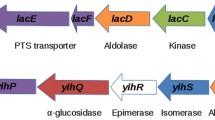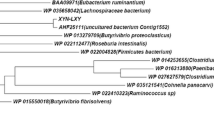Summary
A cluster of three genes involved in d-xylose catabolism (viz. xylose genes) in Lactobacillus pentosus has been cloned in Escherichia coli and characterized by nucleotide sequence analysis. The deduced gene products show considerable sequence similarity to a repressor protein involved in the regulation of expression of xylose genes in Bacillus subtilis (58%), to E. coli and B. subtilis d-xylose isomerase (68% and 77%, respectively), and to E. coli d-xylulose kinase (58%). The cloned genes represent functional xylose genes since they are able to complement the inability of a L. casei strain to ferment d-xylose. NMR analysis confirmed that 13C-xylose was converted into 13C-acetate in L. casei cells transformed with L. pentosus xylose genes but not in untransformed L. casei cells. Comparison with the aligned amino acid sequences of d-xylose isomerases of different bacteria suggests that L. pentosus d-xylose isomerase belongs to the same similarity group as B. subtilis and E. coli d-xylose isomerase and not to a second similarity group comprising d-xylose isomerases of Streptomyces violaceoniger, Ampullariella sp. and Actinoplanes. The organization of the L. pentosus xylose genes, 5′-xylR (1167 bp, repressor) — xylA (1350 bp, D-xylose isomerase) — xylB (1506 bp, d-xylulose kinase) — 3′ is similar to that in B. subtilis. In contrast to B. subtilis xylR, L. pentosus xylR is transcribed in the same direction as xylA and xylB.
Similar content being viewed by others
References
Amore R, Hollenberg CP (1989) Xylose isomerase from Actinoplanes missouriensis: primary structure of the gene and the protein. Nucleic Acids Res 17:7515
Aslanidis C, Schmitt R (1990) Regulatory elements of the raffinose operon: nucleotide sequences of operator and repressor genes. J Bacteriol 172:2178–2180
Batt CA, Jamieson AC, Vandeyar MA (1990) Identification of essential histidine residues in the active site of Escherichia coli xylose (glucose) isomerase. Proc Natl Acad Sci USA 87:618–622
Chassy BM, Flickinger JL (1987) Transformation of Lactobacillus casei by electroporation. FEMS Microbiol Lett 44:173–177
deMan JC, Rogosa M, Sharpe ME (1960) A medium for the cultivation of lactobacilli. J Appl Bacteriol 23:130–135
Dodd IB, Egan JB (1990) Improved detection of helix-turn-helix DNA-binding motifs in protein sequences. Nucleic Acids Res 18:5019–5026
Drocourt D, Bejar S, Calmels T, Reynes JP, Tiraby G (1988) Nucleotide sequence of the xylose isomerase gene from Streptomyces violaceoniger. Nucleic Acids Res 16:9337
Efthymiou C, Hansen CA (1962) An antigenic analysis of Lactobacillus acidophilus. J Infect Dis 110:258–267
Friedman PJ, Imperiale MJ, Adhya SL (1987) RNA 3′-end formation in the control of gene expression. Annu Rev Genet 21:453–488
Gärtner D, Geissendörfer M, Hillen W (1988) Expression of the Bacillus subtilis xyl operon is repressed at the level of transcription and is induced by xylose. J Bacteriol 170:3102–3109
Gold L, Pribnow D, Schneider T, Shinedling S, Singer BS, Stormo G (1981) Translation initiation in prokaryotes. Annu Rev Microbiol 35:365–403
Graves MC, Rabinowitz JC (1986) In vivo and in vitro transcription of the Clostridium pasteuranicum ferredoxin gene. J Biol Chem 261:11409–11415
Harley CB, Reynolds RP (1987) Analysis of E. coli promoter sequences. Nucleic Acids Res 15:2343–2361
Hastrup S (1988) Analysis of the Bacillus subtilis xylose regulon. In: Ganesan AT, Hoch JA (eds) Genetics and biotechnology of Bacilli, vol 2. Academic Press, New York, pp 79–83
Jeffries TW (1983) Utilization of xylose by bacteria, yeasts, and fungi. In: Fiechter A, Jeffries TW (eds) Bioch Eng Biotechnol 27:1–32
Kandler O (1983) Carbohydrate metabolism in lactic acid bacteria. Antonie Van Leeuwenhoek 49:209–224
Kandler O, Weiss N (1986) Regular, nonsporing gram-positive rods: Lactobacillus. In: Sneath PHA, Mair N, Sharpe ME, Holt JG (eds) Bergey's Manual of Systematic Bacteriology, vol 2. Williams, Wilkins, Baltimore, pp 1209–1234
Kreuzer P, Gärtner D, Allmansberger R, Hillen W (1989) Identification and sequence analysis of the Bacillus subtilis W23 xylR gene and xyl operator. J Bacteriol 171:3840–3845
Lawliss VB, Dennis MS, Chen EY, Smith DH, Henner DJ (1984) Cloning and sequencing of the xylose isomerase and xylulose kinase genes of Escherichia coli. Appl Environ Microbiol 47:15–21
Maleszka R, Wang PY, Schneider H (1982) A ColE1 hybrid plasmid containing Escherichia coli genes complementing d-xylose negative mutants of Escherichia coli and Salmonella typhimurium. Can J Biochem 62:144–151
Mitsuhashi S, Lampen JO (1953) Conversion of d-xylose to d-xylulose in extracts of Lactobacillus pentosus. J Biol Chem 204:1011–1018
Moran CP, Lang N, Le Grice SFJ, Lee G, Stephens M, Sonenshein AL, Pero J, Losick R (1982) Nucleotide sequences that signal the initiation of transcription and translation in Bacillus subtilis. Mot Gen Genet 186:339–446
Neuberger MS, Hartley BS, Walker JE (1981) Purification and properties of D-ribulose kinase and d-xylulose kinase from Klebsiella aerogenes. Biochem J 193:513–524
Newbury SF, Smith NH, Robinson EC, Hiles ID, Higgins CF (1987) Stabilization of translationally active mRNA by prokaryotic REP sequences. Cell 48:297–310
Platt T (1986) Transcription termination and regulation of gene expression. Annu Rev Biochem 55:339–372
Posno M, Leer RJ, van Luijk N, van Giezen MJF, Heuvelmans PTHM, Lokman BC, Pouwels PH (1991) Incompatibility of Lactobacillus vectors with replicons derived from small cryptic Lactobacillus plasmids and segregafional instability of the introduced vectors. Appl Environ Microbiol 57:1822–1828
Saari GC, Kumar AA, Kawasaki GH, Insley MY, O'Hara PJ (1987) Sequence of the Ampullariella sp. strain 3876 gene coding for xylose isomerase. J Bacteriol 169:612–618
Sambrook J, Fritsch EF, Maniatis T (1989) Molecular Cloning: A laboratory manual, 2nd edn. Cold Spring Harbor Laboratory Press, Cold Spring Harbor, New York
Sanger F, Nicklen S, Coulson AR (1977) DNA sequencing with chain-terminating inhibitors. Proc Natl Acad Sci USA 74:5463–5467
Sauer RT, Pabo CO (1984) Protein-DNA recognition. Annu Rev Biochem 53:293–321
Schellenberg GD, Sarthy A, Larson AE, Backer MP, Crabb JW, Lindstrom M, Hall BD, Furlong CE (1984) Xylose isomerase from Escherichia coli. J Biol Chem 259:6826–6832
Shamanna DK, Sanderson KE (1979) Genetics and regulation of d-xylose utilization in Salmonella typhimurium LT2. J Bacteriol 139:71–79
Sumiya M, Henderson PJF (1989) The d-xylose binding protein of Escherichia coli. Biochem Soc Trans 17:553–554
Tinoco I, Borer PN, Dengler B, Levine MD, Uhlenbeck OC, Crothers DM, Gralla J (1973) Improved estimation of secondary structure in ribonucleic acids. Nature 246:40–41
Tiraby G, Bejar S, Drocourt D, Reynes JP, Sicard PJ, Farber GK, Glasfeld A, Ringe D, Petsko GA (1989) Genetic, enzymatic, and crystallographic studies of the glucose isomerases of two Streptomyces species. In: Hershberger CL, Queener SW, Hegemann G (eds) Genetics and molecular biology of industrial microorganisms. American Society for Microbiology, Washington, DC, pp 119–126
Vangrysperre W, van Damme J, Vandekerckhove J, de Bruyne CK, Cornelis R, Kersters-Hilderson H (1990) Localization of the essential histidine and carboxylate group in d-xylose isomerases. Biochem J 265:699–705
Wilhelm M, Hollenberg CP (1984) Selective cloning of Bacillus subtilis xylose isomerase and xylulokinase genes in Escherichia coli by IS5-mediated expression. EMBO J 3:2555–2560
Wilhelm M, Hollenberg CP (1985) Nucleotide sequence of the Bacillus subtilis xylose isomerase gene: extensive homology between the Bacillus and E. coli enzyme. Nucleic Acids Res 15:5717–5722
Author information
Authors and Affiliations
Rights and permissions
About this article
Cite this article
Lokman, B.C., van Santen, P., Verdoes, J.C. et al. Organization and characterization of three genes involved in d-xylose catabolism in Lactobacillus pentosus . Molec. Gen. Genet. 230, 161–169 (1991). https://doi.org/10.1007/BF00290664
Received:
Issue Date:
DOI: https://doi.org/10.1007/BF00290664




